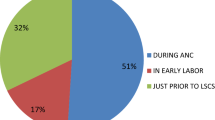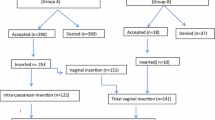Abstract
Objectives
To compare the incidence of visible strings after postplacental intracesarean insertion of Cu375 and CuT380A intrauterine contraceptive devices (IUD).
Methods
This was a prospective, randomized comparative study. A total of 100 women fulfilling the inclusion and exclusion criteria underwent postplacental intracesarean insertion of either Cu375 IUD or CuT380A IUD. Women were followed up at 1, 6 weeks and 3 months after IUD insertion and were questioned about IUD expulsion or removal at each visit. The cervix was inspected to visualize the IUD strings. Data were analyzed by Chi-square test.
Results
At 6-week follow-up, 97.9% women in group A versus 41.7% women in group B had strings visible at the cervical os and at 3 months 100% women in group A versus only 47.9% women in group B (p < 0.001) had visible strings of IUD.
Conclusion
Both Cu375 and CuT380A IUD are safe postpartum method of contraception but Cu375 if used for intracesarean IUD insertion increases the incidence of visible IUD strings. Hence, it avoids radiological investigations and invasive procedures at follow-up visits required to locate the IUD when strings are not visible.
CTRI No. CTRI/2015/09/006221.

Similar content being viewed by others
References
World Health Organization. Medical eligibility criteria for contraceptive use. 5th ed. Geneva: World Health Organization; 2015.
Goldstuck ND, Steyn PS. Intrauterine contraception after cesarean section and during lactation: a systematic review. Int J Women Health. 2013;5:811–8.
Levi E, Cantillo E, Ades V, Banks E, et al. Immediate postplacental IUD insertion at cesarean delivery: a prospective cohort study. Contraception. 2012;86:102.
Fox MC, Oat-Judge J, Severson K, et al. Immediate placement of intraiuterine devices after first and second trimester pregnancy termination. Contraception. 2011;83:34–40.
Bhutta SZ, Butt IJ, Bano K. Insertion of intrauterine contraceptive device at cesarean section. J Coll Phys Surg Pak. 2011;21(9):527–30.
Singal S, Bharti R, Dewan R, et al. Clinical outcome of post placental Copper T 380A insertion in women delivering by cesarean section. J Clin Diagn Res. 2014;8(9):OC01–4.
Gutgutia I, Kumari Usha Rani SP, Renu Arora S. Comparative evaluation of Postpartum versus post MTP insertion of intrauterine contraceptive device. Int J Reprod Contracept Obstet Gynecol. 2015;4(1):23–9.
Lester F, Kakaire O, Byamugisha J. Intracesarean insertion of CuT380A versus 6 weeks postcesarean: a randomized clinical trial. Contraception. 2015;91:198–203.
Dewan R, Dewan A, Singal S, et al. Non-visualisation of strings after postplacental insertion of Copper- T 380A intrauterine device. J Fam Plan Reprod Health Care. 2016;0:1–9.
Prabhakaran S, Chuang A. In office retrieval of intrauterine contraceptive devices with missing strings. Contraception. 2011;83(2):102–6.
Mishra S. Evaluation of safety, efficacy and expulsion of post-placental and Intra cesarean insertion of intrauterine contraceptive devices. J Obstet Gynecol India. 2014;64(5):337–43.
Lucksom PG, Kanungo BK, Sebastian N, et al. Comparative study of interval versus postpartum Cu-T insertion in a central referral hospital of North East India. Int J Reprod Contracept Obstet Gynecol. 2015;4(1):47–51.
Arshad F, Ejaz L, Noreen H, et al. Trans cesarean insertion of intrauterine contraceptive device. JSOGP. 2014;4:73–8.
Author information
Authors and Affiliations
Corresponding author
Ethics declarations
Conflict of interest
Dr. Kavita Agarwal, Dr. Rupali Dewan, Dr. Pratima Mittal and Dr. Abha Aggarwal declare that they have no conflict of interest.
Ethical Approval
All procedures followed were in accordance with the ethical standards of the responsible committee on human experimentation (institutional and national) and with the Helsinki Declaration of 1975, as revised in 2008 (5).
Informed Consent
Informed consent was obtained from all patients for being included in the study.
Additional information
Dr. Kavita Agarwal is a Assistant Professor in Department of Obstetrics and Gynaecology, Safdarjung Hospital, New Delhi; Dr. Rupali Dewan is a Professor and Consultant in Department of Obstetrics and Gynaecology, Safdarjung Hospital, New Delhi; Dr. Pratima Mittal is a Professor and Head of Department in Department of Obstetrics and Gynaecology, Safdarjung Hospital, New Delhi; Dr. Abha Aggarwal is a Scientist F in NIMS, India.
Rights and permissions
About this article
Cite this article
Agarwal, K., Dewan, R., Mittal, P. et al. Visibility of Strings After Postplacental Intracesarean Insertion of CuT380A and Cu375 Intrauterine Contraceptive Device: A Randomized Comparative Study. J Obstet Gynecol India 67, 324–329 (2017). https://doi.org/10.1007/s13224-017-0965-8
Received:
Accepted:
Published:
Issue Date:
DOI: https://doi.org/10.1007/s13224-017-0965-8




